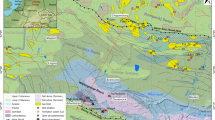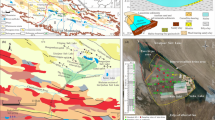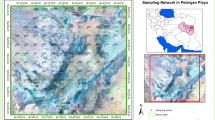Abstract
These Kupferschiefer deposits were probably formed as a result of a mixing of two brines. The upper cold brine (UCB) is an unmineralized brine rich in Na, Ca, Cl and SO4, with a pH>7 and originating from evaporites overlying the metal-bearing Zechstein rocks. The lower hot brine (LHB) rich in Mg, K, Cl, SO4 and CO3 with a pH<=7 formed in sediments in the central part of the Zechstein basin at a depth of 7,000 m. This brine was subjected to heating and upward convection toward the Fore-Sudetic monocline along the bottom of the Z1 carbonates. During its migration, it caused albitization, serpentinization and leaching of the primary metal deposits in rocks underlying the Zechstein becoming enriched in heavy metals. The mineralization process, being a result of the mixing of the two brines (UCB and LHB), and catalytic oxidation of the organic matter of the black shale were initiated at shallow depths in the area of the Fore-Sudetic monocline. The boundary of the two brines generally overlapped the strike of the black shale.
Parts of the deposit with shale-free host rock suggest that the action of two brines alone was capable of producing economic concentrations of Cu, Pb and Zn. Where the boundary of the two brines overlaps the autooxidation zone (the black shale bottom) and also coincides with γ radiation of thucholite, concentrations of noble metals result.
The characteristic vertical distribution of the triplet Cu→Pb→Zn from the bottom upward is universal in the Kupferschiefer environment.
Similar content being viewed by others
References
Banaś, M., Salamon, W., Piestrzyński, A., Mayer, W.: Replacement phenomena of terrigenous minerals by sulfides in copperbearing Permian sandstones in Poland, 3–9. In: G.C. Amstutz, A. El Goresy, G. Frenzel, C. Kluth, G. H. Moh, A. Wauschkuhn, R.A. Zimermann (Eds) Ore genesis — The state of the art, 804 pp, Berlin-Heidelberg-New York: Springer, 1982
Bartholome, P., Evrard, P., Katekesha, F., Lopez-Ruiz, L., Ngongo, M.: Diagenetic ore-forming process at Kamoto, Katanga, Republic of the Congo, 21–41. In: G.C. Amstutz, A.J. Bernard (Eds) Ores in sediments, 350 pp, Berlin-Heidelberg-New York: Springer, 1973
Bathurst, R.G.C.: Carbonate sediments and their diagenesis. Elsevier, 620 pp, 1971
Bischoff, J.L., Radtke, A.S., Rosenbauer, R.J.: Hydrothermal alteration of greywacke by brine and seawater: roles of alteration and chloride complexing on metal solubilisation at 200° and 350°C. Econ. Geol. 76:659–676 (1981)
Bojarska, J., Bojarski, L.: Groundwaters of the Polish Permian and possibilities of their utilisation, 617–624. In: Preceedings of the Int. Symp. Central Europ. Permian, Jablonna 1978, Geol. Inst. Publ., 651 pp, 1981
Bojarski, L., Płochniewski, Z., Stachowiak, J.: Well out of anomalously-high-pressure brines from the Rotliegendes deposits. Przegl. Geol. 284:719–720 (1976, in Polish)
Bonatti, E., Fisher, D.E., Jesun, O., Rydell, H.S.: Postdepositional mobility of some transition elements, phosphorus, uranium and thorium in deep sea sediments. Geochim. Cosmochim. Acta 35:189–202 (1971)
Brongersma-Sanders, M.: On the geographical association of strata-bound ore evaporites. Mineral. Deposita 3:286–291 (1968)
Cathles, L.M., Smith, A.T.: Thermal constraints on the formation of Mississippi Valley-type lead-zinc deposits and their implications for episodic basin dewatering and deposits genesis. Econ. Geol. 78:983–1002 (1983)
Davidson, C.F.: On the origin of some strata-bound sulphide ore deposits. Econ. Geol. 57:265–273 (1962)
Degens, E.T., Ross, D.A.: Hot brines and recent heavy metal deposits in the Red Sea. 600 pp, Berlin-Heidelberg-New York: Springer, 1969
Harańczyk, Cz.: Ore mineralisation of the Lower Zechstein reducing sediments of the Fore-Sudetic monocline. Arch. Mineral. 30:14–139 (1972, in Polish)
Heflik, W., Krzyczkowska, A.: Magmatic rocks underlying the lower Silesian mining area. Spraw. Kom. Nauk. PAN w Krakowie, XIX/2 (1975)
Jerzykiewicz, T., Kijewski, P., Mroczkowski, J., Teisseyre, A.K.: Origin of the Weissliegendes deposits in the Fore-Sudetic monocline. Geol. Sudetica 11:57–59 (1976, in Polish)
Jung, W., Knitzschke, G.: Kupferschiefer in the German Democratic Republic (GDR) with special reference to the Kupferschiefer deposit in the southeastern Harz Foreland, 352–406. In: K.H. Wolf (Ed) Handbook of strata-bound and stratiform ore deposits, Part II, Cu, Zn, Pb and Ag Deposits, v 6: 585 pp, Elsevier 1976
Kłapciński, J.: Lithology, fauna, stratigraphy, and paleogeography of the Permian in the Fore-Sudetic monocline. Geol. Sudetica 5:77–135 (1971)
Kucha H.: Myrmekitic structures of haematite in bornite and their genesis, Zechstein copper deposits, Poland. Mineral. Pol. 11:27–31 (1980)
Kucha, H.: Precious metal alloys and organic matter in the Zechstein copper deposits, Poland. Tschermaks Mineral. Petr. Mitt. 28:1–16 (1981)
Kucha, H.: Platinum-group metals in the Zechstein copper deposits, Poland. Econ. Geol. 77:1578–1591 (1982)
Kucha, H.: Precious metal bearing shale from Zechstein copper deposits Poland. Trans. Instn Min. Metall. (Sect. B: Appl. earth sci.) 92:72–79 (1983)
Kucha, H.: Felspar, clay, organic and carbonate receptors of heavy metals in Zechstein deposits (Kupferschiefer type), Poland. Trans. Instn Min. Metall. (Sect. B: Appl. earth sci.) 133–146 (1985)
Lambert, J.B., Bubela, B.: Banded sulphide ores: the experimental production of monomineralic sulphide bands in sediments. Mineral. Deposita 5:97–102 (1970)
Ling, O., Ramon, B.: Coagulation of humic colloids by metal ions. Soil. Sci. 106:220–224 (1968)
Listova, L.P., Bondarenko, G.P.: Precipitation and differentiation of Cu, Pb and Zn in conditions of sedimentary zone. 99 pp, Nedra 1978 (in Russian)
Łaszcz-Filakowa, B.: Groundwaters of Saxonian and Zechstein reservoir rocks in the Fore-Sudetic monocline, their chemistry and genesis. 625–644. In: Proceedings of the Int. Symp. Central Europ. Permian, Jabłonna 1978, Geol. Inst. Publ., 655 pp, 1981
Majorowicz, J.: Geothermal degree values in Poland within the 200–2,500 m depth range. Kwart. Geol. 15:891–900 (1971, in Polish)
Mayer, W., Piestrzyński, A.: Geology and mineralisation of Rudna mine. Ph.D. Univ. of Mining and Metallurgy, Kraków, Poland. 270 pp (1982, in Polish)
Nielsen, H.: Sulfur isotopes, 283–312. In: E. Jäger and J.C. Hunziker (Eds) Lectures in isotope geology. 329 pp, Berlin-Heidelberg-New York: Springer, 1979
Osika, R., Poborski, J.: Halogenic map. Mineralogical Atlas of Poland. Warszawa 1970
Poborski, J.: On the tectogenesis of some diapiric salt structures in central Poland, Upper Permian. Fourth Salt Symp., v 1 and 2, 1975
Renfro, A.R.: Genesis of evaporite-associated stratiform metalliferous deposits — A sabkha process. Econ. Geol. 69:33–45 (1974)
Rentzsch, J.: The Kupferschiefer in comparison with the deposits of the Zambian copper belt, 395–418. In: P. Bartholome (Ed) Gisements stratiformes et provinces cupriferes. 427 pp, 1974
Rucklidge, J.: Mobilisation of nickel and platinum metals during serpentinisation of ultramaffic rocks. Platinum Conf., Univ. Melbourne 1971
Rydzewski, A.: The origin of Zechstein polimetallic mineralisation. Przegl. Geol. 4:176–181 (1976, in Polish)
Siemaszko, E.: Permian effusive rocks from SW part of the Fore-Sudetic monocline. Kwart. Geol. 22:571–584 (1978, in Polish)
Sokołowski, J.: Main theses of the work “The role of halokinesis in the development of the Young Mesosoic at Mogilno. Przegl. Geol. 150:381–386 (1965, in Polish)
Vine, J.D., Turtelot, E.B.: Geochemistry of black shale deposits — a summary report. Econ. Geol. 65:253–272 (1970)
Wagner, R., Peryt, T.M., Piatkowski, S.: The evolution of the Zechstein sedimentary basin in Poland. 69–83. In: Proceedings of the Int. Symp. Central Europ. Permian, Jabłonna 1978, Geol. Inst. Publ. 655 pp, 1981
Waters, W.A.: Mechanisms of oxidation of organic compounds. 170 pp. Methuen, J. Wiley, 1963
Wedepohl, K.H., Delavaux, M.H., Doe, B.R.: The potential source of lead in the Permian Kupferschiefer Bed of Europe and some selected Paleozoic mineral deposits in the Federal Republic of Germany. Contrib. Mineral. Petrol. 65:273–281 (1978)
Weiss, A., Amstutz, G.C.: Exchange reactions on clay minerals and cation selective membrane properties — a possible mechanism of economic metal concentration. Mineral. Deposita 1:60–66 (1966)
Wolf, K.H.: Terminologies, structuring and classification in ore and host-rock petrology, 1–329. In: K.H. Wolf (Ed) Handbook of strata-bound and stratiform ore deposits, Part III, General Studies, v 8, 592 pp, Elsevier 1981
Wyzykowski, J.: Zechstein copper-bearing formation in Poland. Przegl. Geol. 3:117–122 (1971, in Polish)
Author information
Authors and Affiliations
Rights and permissions
About this article
Cite this article
Kucha, H., Pawlikowski, M. Two-brine model of the genesis of strata-bound Zechstein deposits (Kupferschiefer type), Poland. Mineral. Deposita 21, 70–80 (1986). https://doi.org/10.1007/BF00204365
Received:
Accepted:
Issue Date:
DOI: https://doi.org/10.1007/BF00204365




